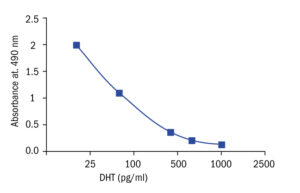Dihydrotestosterone ELISA
5-dihydrotestosterone (DHT) is a steroid similar to testosterone and androstenedione, which belong to a vlase called androgens. DHT is a C19 steroid and possesses androgenic activity. The bulk of androgen production takes place mainly in the Leydig cells of the testes. Androgens circulate in the blood bound to proteins, especially sex hormone binding globulin (SHBG) and albumin. A trace amount of these steroids circulate in the unbound form in the blood and are referred to as the free fractions. DHT has at least three times the binding affinity for SHBG than testosterone. In males about 70% of DHT is derived from peripheral conversion of testosterone, while in females most of the DHT is derived from androstenedione. The major organ to neutralize androgens is the liver. Therefore in the liver the steroid hormones undergo structural modifications that are generally regarded as prerequisites for their biological inactivation. Some metabolites are formed and some are returned to the circulation
Research topic
Steroid hormones
Type
Competitive ELISA, Immobilized antigen
Applications
Serum
Sample Requirements
50 μl/well
Storage/Expiration
Store the complete kit at 2–8°C. Under these conditions, the kit is stable until the expiration date (see label on the box).
Calibration Curve

Calibration Range
25–2500 pg/ml
Limit of Detection
6.0 pg/ml
Intra-assay (Within-Run)
CV = 6.9%
Inter-assay (Run-to-Run)
CV = 8.5%
Spiking Recovery
90,60%
Dilutation Linearity
95,40%
– Mishra JS, Hankins GD, Kumar S. Testosterone downregulates angiotensin II type-2 receptor via androgen receptor-mediated ERK1/2 MAP kinase pathway in rat aorta. J Renin Angiotensin Aldosteron. 2016 Oct;17 (4)
– Saddick SY. Ovarian surface epithelium receptors during pregnancy and estrus cycle of rats with emphasis on steroids and gonadotropin fluctuation. Saudi Journal of Biological Sc. 13 March 2014;

